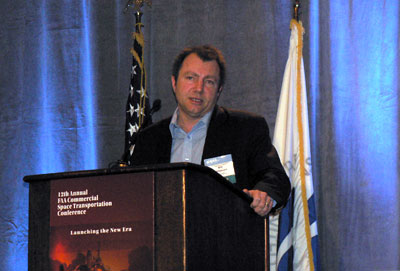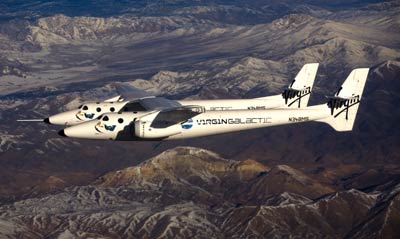Virgin looks beyond space tourismby Jeff Foust
|
| “If we just rebuilt WhiteKnightOne and rebuilt SpaceShipOne, we would have basically been restricted to space tourism for a period of time until we then could have developed a second model,” Whitehorn said. “Luckily we were saved by the early customers.” |
Scaling up to a larger vehicle allows Virgin to address markets beyond space tourism, Whitehorn said, with four in particular of interest to the company. The first is suborbital scientific research, ranging from atmospheric and space sciences to microgravity experimentation. A market study performed for Virgin by an outside group found that there is over $300 million a year in NASA funding alone dedicated to sounding rocket research, space life sciences work, education, and aeronautics that could be addressed by SpaceShipTwo (SS2).
Virgin has already made a small step into that market with an agreement announced last fall with NOAA to carry atmospheric sensors on the WhiteKnightTwo (WK2) carrier aircraft as well as SpaceShipTwo; some of that data will be used to help calibrate NASA’s Orbiting Carbon Observatory spacecraft slated for launch later this month. That agreement is under a no exchange of funds basis, but he said that the agreement itself helps burnish the company’s scientific credentials for other customers.
Two other markets the company is looking at with the WK2/SS2 combination are astronaut training and technology testing and demonstration. The astronaut training, Whitehorn said, could be done using either WK2 or SS2: in addition to flying parabolic arcs to provide brief periods of microgravity, the aircraft can also create up to 6 Gs of acceleration to simulate the forces of launch and reentry. “That’s a supremely interesting capability, and we believe there will be a market for it,” he said.
The last, and perhaps most intriguing, market Virgin is examining is low-cost launches of small satellites. In this scenario WK2 would carry aloft not SS2 but an expendable booster of some undetermined design capable of placing up to 200 kilograms into low Earth orbit. Virgin is working with the company widely considered to be the leader in the smallsat industry, Surrey Satellite Technology Limited (SSTL), to study the viability of this market. (Ironically, SSTL was acquired last year by EADS Astrium, a company that has announced plans to develop its own suborbital spaceplane.)
The goal of this effort would be to develop a system that could launch smallsats for no more than $2 million, with the flexibility to launch from almost any location, and to go from contract to launch in a matter of weeks. One complicating factor is that Virgin doesn’t have any money now to spend on development of the expendable booster. “I work for a very visionary organization, and they are funding us through one of the most difficult economic periods in history to get WhiteKnightTwo and SpaceShipTwo finished,” Whitehorn said. “But if I went to ask them for the money to build a smallsat launcher at the same time, I know what the answer would be, so I haven’t been to ask them.”
He added, though, that there are a number of existing launch vehicles that could be readily adapted to launch from WK2. Virgin is in “early-stage” discussions with a number of vehicle developers in this area, he said, as well as working with SSTL to study the smallsat market.
Whitehorn’s point was that none of these additional markets beyond space tourism would have been enabled had Virgin stuck with its original plans for a SpaceShipOne-sized vehicle. “If we just rebuilt WhiteKnightOne and rebuilt SpaceShipOne, we would have basically been restricted to space tourism for a period of time until we then could have developed a second model,” he said. “Luckily we were saved by the early customers.”
 Will Whitehorn talks about Virgin Galactic and the markets it is pursuring in a speech February 6 at the FAA Commercial Space Transportation Conference. (credit: J. Foust) |
Sizing up the competition
Late in his speech Whitehorn took a few minutes to compare Virgin Galactic with a number of other ventures in this market, particularly in their ability to serve markets beyond space tourism. “We went for what we went for because of the flexibility we could see in the first stage air launch,” he explained. “That doesn’t mean to say that other systems won’t have a relevance eventually to space tourism” but, he believes, would not be well-suited to access other markets.
For example, he said that Virgin looked at spaceplanes like those proposed by Astrium and Rocketplane Global that take off under jet power and later light a rocket engine to fly to space, but didn’t “intrinsically like” it because of the jet engines and reentry profile. “It could work,” he said, “but the problem is that it’s just for space tourism. I couldn’t see other applications for these kinds of technologies.”
As for XCOR’s Lynx Rocketplane, Whitehorn had a similar assessment: feasible, but limiting. “I think these guys can make this work, there’s no doubt about it,” he said. “But for us, it doesn’t do the job that we want it to do… It’s not much good for anything else but tourism.”
| “It could work,” Whitehorn said of the spaceplanes proposed by EADS Astrium and Rocketplane Global, “but the problem is that it’s just for space tourism. I couldn’t see other applications for these kinds of technologies.” |
He was more dismissive of other ventures, including Armadillo Aerospace’s vertical takeoff and landing design unveiled last year, where two people fly inside a large clear bubble. “If goldfish want to go to space, it’s spot on,” he quipped. He also wasn’t keen about a more obscure company, Copenhagen Suborbitals, which has proposed a small rocket with just enough room for a single passenger. “It doesn’t do the job for the customer too well, since you’re not going to experience a lot of weightlessness.”
Those assessments were no doubt controversial, particularly since some of these companies are indeed going after markets like suborbital science and technology demonstration. (Indeed, an executive with one of those companies was seen having a spirited conversation with Whitehorn after his speech.) It also excludes companies like Masten Space Systems and TGV Rockets that are largely ignoring space tourism in favor of science and other markets.
Current status and future plans
Whitehorn’s speech came just one day after WK2 flew its second test flight from Mojave Air and Space Port in California. He said that he and Richard Branson “got a very excited email from Burt [Rutan]” after the flight, which Whitehorn said was “flawless”. Another Virgin Galactic official, Enrico Palermo, said during a panel session later Friday at the conference that the aircraft flew to an altitude of about 5,500 meters (18,000 feet) during the hour-and-a-half flight, reaching speeds of 240 km/h (130 knots).
While WK2 continues its series of test flights, work on SS2 continues. Whitehorn said that the spacecraft is now “just under” 80 percent complete, and is on track to begin glide tests by the end of this year. He did not specify any other schedule milestones for the program, including when WK2 and SS2 would enter commercial service.
While Virgin examines these other markets, the company is continuing to build its customer base for its space tourism flights. Whitehorn said that the company has nearly 300 customers now and $39 million in customer deposits. Despite the current economic crisis, he said they continue to sign up customers, including two earlier that week. A few customers have asked for their deposits back, including one person who lost all his money in the Bernard Madoff scandal. “He could say to us that actually we were one of only investments he’d made that hadn’t gone bad” because he was able to recover his $200,000, Whitehorn said.
| “If WhiteKnightTwo works, and SpaceShipTwo works, and we make a commercial success with it, I’m pretty sure there will be a WhiteKnightThree and a SpaceShipThree.” |
That space tourism market, he said, forms the core of a “serious investment opportunity” for Virgin. “We don’t need, to make money out of the system, to do anything but the tourism part,” he said. However, in addition to the science and training markets the company is interested in, Whitehorn sees possibilities in launch and other alternative WK2 payloads, as well as patented intellectual property in the system. “The rest is going to be the bonus,” he said.
Whitehorn said that once WK2 and SS2 enter service, the system could potentially be profitable in its first year, and soon thereafter even become a publicly-traded company. “It’s quite clear that, obviously subject to market conditions in a couple of years’ time, we’d be able to IPO this business potentially.” He added that they were now open to considering “relevant external investment” provided those opportunities offer industrial partnerships or other synergies.
Those additional markets and the revenue they generate would, in turn, lead to the development of a WhiteKnightThree and SpaceShipThree, although exactly what form those vehicles would take isn’t yet known. “We’re not planning a WhiteKnightThree, we’re not planning a SpaceShipThree,” Whitehorn said. “But I work for Virgin. If WhiteKnightTwo works, and SpaceShipTwo works, and we make a commercial success with it, I’m pretty sure there will be a WhiteKnightThree and a SpaceShipThree.”
